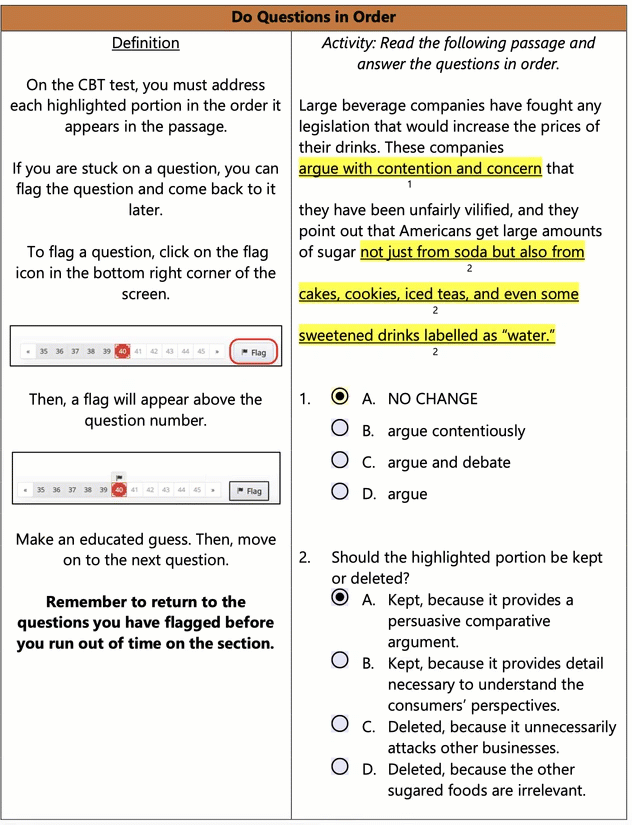Testing on computer is rapidly becoming the new normal. ACT led the transition for college admissions exams, shifting international students to a computer-based test (CBT) as early as 2018, and the SAT later followed with a digital, computer-adaptive exam.
Despite these changes, many test prep companies still recommend that CBT students continue to practice with the paper versions of exams. The thinking is that the content of the test is the same, so the concepts students study on paper will appear the same way on the screen. However, we’ve found that this approach ultimately leads to a few key challenges when students need to apply their content knowledge on test day:
- Students don’t know how to use the on-screen tools to their full advantage.
- Students become used to certain habits and strategies that work well on paper but don’t always translate to the computer.
- Students’ practice test scores don’t consistently and accurately predict their performances on test day.
To address these challenges, ArborBridge's curriculum team has designed CBT lessons and practice materials specifically for students prepping for the computer-based ACT.
Here's how our curriculum helps students overcome the biggest challenges of the transition to computer-based testing.
Challenge #1: Students don’t know how to use the on-screen tools to their full advantage.
Solution: ArborBridge’s ACT lessons teach students when and how to use their tools on each section of the computer-based test.
Our CBT lessons teach students how to make the most of their on-screen tools—a major advantage that's not possible when a student is using paper exams or exploring ACT's practice tests on their own. For example, ArborBridge students learn that the highlighter can be especially helpful on the English section, where they can highlight independent clauses or other sentence pieces as they answer punctuation questions. During tutoring sessions, students get hands-on practice with these tips and tricks.
By weaving CBT-specific strategies into targeted lessons, the ArborBridge curriculum allows students to learn ACT content while continuing to master the CBT format itself—through clickable radio buttons, highlighted text, and more. Students get regular practice using CBT tools and answering on-screen questions so that they can maximize their performance on test day.
Here's an example of a lesson a student might cover with her tutor:

Challenge #2: Students become used to certain habits and strategies that work well on paper but don’t always translate to the computer.
Solution: ArborBridge students practice with CBT-style lessons and homework assignments that help them build the right habits from day one.
In order to build the right habits from day one, students need to work with actual CBT materials as much as possible. For example, while it's easy to do questions out of order and bubble in random guesses when running out of time at the end of a section on the paper test, students need to adapt those strategies and adjust their pacing when working on a computer.
Our new CBT curriculum means that students can practice strategies specific to the computer-based version of the ACT from the very beginning. Specialized lessons and homework assignments allow students to master content and targeted skills while continuing to strengthen the CBT-specific habits and strategies that will ensure their success on test day.
Challenge #3: Students' practice test scores don’t consistently and accurately predict their performances on test day.
Solution: ArborBridge's new ACT materials provide students with more accurate ways of measuring their progress and seeing how they perform on computer-based tests.
The format of the test matters more than you might expect. Students who do most of their practice on paper often see surprising variations in their scores on official exams. We experienced this firsthand when our students sat for the very first computer-based ACT in September 2018. Because ACT had released its only CBT practice exam just a few months prior, the first group of students had less time and fewer opportunities to master the CBT format, and many saw score fluctuations as a result. One of our students, William, reported that transitioning to the computer-based test affected his pacing and overall approach to each section, and his composite score unexpectedly dropped from a 25 to a 24. After weeks of intensive work in CBT-specific test-taking strategies, William sat for the test again the following month and achieved a 5-point score increase, earning a 29.
For an accurate sense of how they'll perform on the official test, students need to practice with CBT materials. Answering practice questions on a computer gives students a clearer understanding of their pacing, helps them build their on-screen test-taking stamina, and more accurately simulates official testing conditions.
Practicing the right way with the right resources not only gives students a better measure of their progress but also makes a huge difference in how well they perform on the official test. Since the initial CBT rollout, our students who have worked off of CBT materials from day one have been able to achieve scores in line with their practice test performances—not to mention they report feeling better prepared and more confident on test day.
To learn more, reach out to us here.
Need more individualized advice?
The recommendations above are general suggestions. If you have specific questions, reach out to our experts here. We’re happy to help in any way we can.
About ArborBridge
ArborBridge is the global leader in innovative, digital, one-on-one tutoring. With nearly a decade of experience teaching students online, ArborBridge supports students of all kinds: home schoolers, AP students, test preppers, and more. Our tutors specialize in creating personalized plans and in providing compassionate support for students and families.







